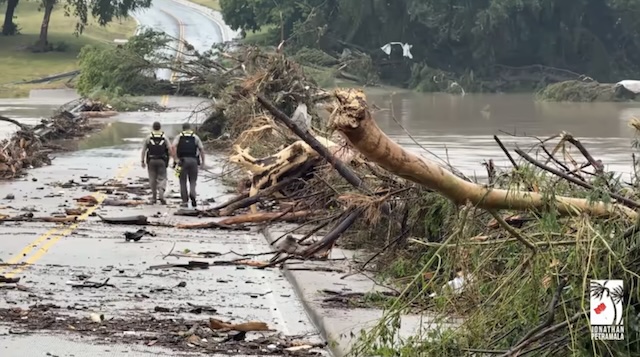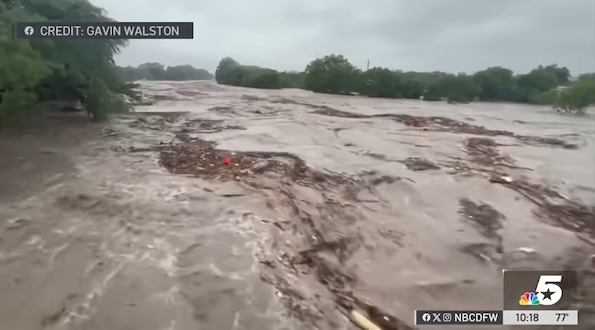
Some lives could have been saved with better local warnings, but federal government cuts to FEMA, National Weather Service and NOAA are leaving communities ill-prepared for disasters.
The horrors of learning about the ever-mounting number of tragic deaths are being felt around the country. Scrutiny and criticism over the disaster response is growing as we continue to learn about the scale of intentional, harmful government cuts to disaster preparation and response.
A deadly flash flood took place over the 4th Of July weekend in Central Texas that has killed 129 people, with 103 dead in Kerr County, known as ‘Flash Flood Alley’. The worst of the flooding occurred here as the Guadalupe River rose to some 26 feet. There are still 170 unaccounted for statewide with 161 of them in Kerr County.
The death toll included people camping along the river as well as locals who lived near the river. he deaths receiving the most news are the 36 or more children who died, most of them attendees at the multi-building 99-year-old Camp Mystic, well-known for having been attended by many prominent Texans over the years.
The reasons for the high death toll are many: the Guadalupe River is well known for its flash floods, and gaps in the warning systems left many unaware. There have been serious floods on the river in 1932, 1978 and 1987. At Camp Mystic, NPR found at least eight buildings, including four cabins used to house younger campers, are located inside what FEMA designates a floodway, the most dangerous area of the floodplain. Some are asking why the camp was built in such a hazardous area, but weather conditions were likely different 100 years ago, and FEMA’s maps are not keeping up with current and changing weather conditions as climate change intensifies.

Local Warning Systems Were Inadequate To Reach Everyone Affected
There was no system of sirens to alert people. During the night cell phone alerts weren’t heard by everyone. One system of cellphone alerts requires the user to opt into the system, and people vacationing there might not have known of that system. There’s another system used by the county called CodeRED. CBS News reveals a firefighter, about an hour into the flood response at 4:22 a.m., asked a dispatcher, “Is there any way we can send a CodeRED out to our Hunt residents asking them to find higher ground or stay home?” The dispatcher responds, “Stand by, we have to get that approved with our supervisor.” It’s not clear what happened next or when. When pressed about emergency alerts at news conferences, several officials refused to answer directly and instead said they were focused right now on finding the victims.
Requests To Get An Improved Local Warning System Were Denied
J.R. Singley, of Kerrville, said river communities need a better flood warning system, including sirens like those that warn of tornadoes. “We lost 24 or 25 or 26 kids,” he said. “These young kids, they were terrorized by this thing. To die like that is, in my opinion, terrible.” He added: “If we’d had a decent warning system, it would have made all the difference in the world.”
We now know that for years local leaders talked about getting a system that didn’t rely on cellphones for this area. Kerr County had a plan as far back as 2018 to install sirens that could be activated to warn about floods and other disasters, and plans to include: high water detection, precipitation sensors, automatic crossing barriers, and a web-based platform. It was projected to cost around a million dollars. In 2017 and again in 2018, state officials denied the county a $1 million grant to build such a flood warning system. See NPR story here.
National Weather Service Critical Staffing Cuts
The flooding came amid a staffing cutback at the National Weather Service implemented by President Trump. The Austin/San Antonio office of the NWS is short of six employees, and the nearby San Angelo office is short of four employees, according to Tom Fahy, the legislative director for the National Weather Service Employees Organization, a union representing government employees, NBC News reported. Rick Spinrad, former NOAA administrator during the Biden administration, told Scripps News that the local National Weather Service in San Antonio increased staff on hand for Friday morning’s storms, but key employees were no longer present. The office was working without a science and operations officer or warning coordination meteorologist after both left in April. “We do know that at the San Antonio-Austin Weather Forecast Office, there was not a warning coordination meteorologist,” he said. “That is the critical position that serves as the liaison, the connection, with the emergency managers, the one who makes sure those warnings are received and also is in steady and constant communication, should be, with the emergency managers in the area.
Early indications are that because there was no warning coordination meteorologist and probably because there was a lack of communication sufficiency, the emergency managers were not able to get their discussion with the people at the weather forecast office and make the decisions that they needed to make.”
National Weather Service Issued Timely Warnings But A Key Position Was Vacant
The loss of the warning coordination meteorologist impacts coordination with the local emergency managers. Spinrad said that warnings were timely and accurate ahead of this massive Texas flooding.
The National Weather Service issued its first flash flood warning for the region at 1:14 a.m., with the first flash flood emergency warning issued at 4:03 a.m. “A good three to four hours before the devastating flood hit, the Weather Service put out a flash flood warning, which used adjectives such as ‘considerable’ and ‘catastrophic,'” Spinrad said. “So we knew there was a major event happening.
The question is, even though the Weather Service did their job in getting watches and warnings and wireless emergency alerts out, were those messages received and acted upon? And right now, there’s obviously a need to assess how emergency managers received information, how the people in harm’s way got the information that they needed to take action.”
Government Response To The Flood Disaster
When reporters and others raise questions about the warning delays, Trump and Governor Abbott refer to such questioners as ‘evil’ and ‘losers’. This is feeding growing anger and frustration. Families in Texas are now demanding a better warning system. An online petition started by the community calls on the county to make funding an outdoor siren system a top priority.
On the state level, Texas lawmakers are facing scrutiny for rejecting proposals aimed at reforming the state’s flood alert systems. Lt. Gov. Dan Patrick and Gov. Greg Abbott are just now discussing paying for siren warning systems along river communities prone to flash flooding. “Had we had sirens along this area, up and down … that would’ve blown very loudly,” he told the news channel. “It’s possible that that would’ve saved some of these lives.” This issue has now been added to the list of priorities (such as redistricting that President Trump wants before the midterm elections) for the special legislative session this summer. Will the state finally pay for a warning system for the Guadalupe River area?
Cuts To FEMA and Delays In Disaster Response
FEMA too faces intense scrutiny over its response to the floods in Texas that have killed more than 120 people. After floods, hurricanes and other disasters, survivors can call FEMA to apply for different types of financial assistance. People who have lost their homes, for instance, can apply for a one-time payment of $750 that can help cover their immediate needs, such as food or other supplies.
The Trump administration last month ended FEMA’s longstanding practice of going door-to-door in disaster-battered areas to help survivors apply for aid. According to documents reviewed by The New York Times, FEMA did not answer nearly two-thirds of calls to its disaster assistance line. Kristi Noem, the homeland security secretary, who has instituted a new requirement that she personally approve expenses over $100,000, did not renew the hundreds of contractors at call centers when their contracts ran out July 5 until five days after the contracts expired. She also did not authorize the deployment of FEMA’s search-and-rescue teams until three days after the flooding began.
FEMA might be eliminated and unavailable to help with future disasters. Kristi Noem said, “The president and I have had many, many discussions about this agency. I want to be very clear. The President wants it eliminated as it currently exists. He wants a new agency.” Only Congress can fully eliminate FEMA, although the executive branch can act on its own to restructure or reduce the size of the agency.
Trump recently appointed Governor Abbott to his newly-created FEMA Review Council. Abbott mentioned that he looks forward to ongoing collaborative efforts with the Trump Administration to empower states to be the primary emergency response team for their local communities during a disaster. Emergency management experts and state disaster response officials say that FEMA plays a crucial role that state governments cannot handle on their own. It appears Trump is using the Council to pave the way for the states to take over the functions of FEMA, but they will not have all the resources that a nationwide agency would have. How much can a state do to prevent future flood deaths, even with a very large budget, if the scientists assigned at the national level to weather predictions are fired?
How Can We The People Respond?
Many are beginning to realize we are on our own and need to support one another. A wide variety of first responder search and rescue teams from Texas, Ohio, California, and a group of 13 fire fighters from Mexico arrived on the scene of devastation to help. One of the Mexican volunteers, José Omar Llanas Hernández, told CBS News he “feels immense pride in being able to serve communities and aid in rescues in any country”. Two resourceful young Mexican counselors at Camp Mystic led the younger girls in one of the buildings to remain calm and get prepared for evacuation. As the Guadalupe River rose, some local volunteers and neighbors made valiant attempts to save as many lives as they could. HEROCIALLY, ONE MAN SAVED TWO GIRLS BUT LOST HIS LIFE. Now the search teams will be continuing to comb the areas along 60 miles of the Guadalupe River. Their efforts could take months and some bodies may never be recovered.
The task will fall to us to organize ourselves to demand that the positions and functions being cut at FEMA, the National Weather Service and NOAA not only be restored but strengthened. Climate change is creating worse weather events that threaten to take many more lives.
If you wish to help the flood victims: Contact Kerr County Flood Relief Fund

